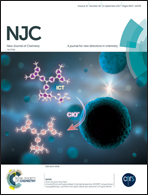Fabrication of an acetone sensor based on facile ternary MnO2/Gd2O3/SnO2 nanosheets for environmental safety
Abstract
The facile hydrothermally synthesized (at low temperature, in alkaline medium of pH 10.5) nanosheets (NSs) of MnO2/Gd2O3/SnO2 are well crystalline-doped ternary metal oxides. The prepared sample was characterized via Fourier-transform infrared spectroscopy (FTIR), ultraviolet visible spectroscopy (UV/vis), field emission scanning electron microscopy (FESEM), X-ray photoelectron spectroscopy (XPS), energy-dispersive X-ray spectroscopy (EDS), and powder X-ray diffraction (XRD). A thin layer of NSs was coated on a glassy carbon electrode (GCE) with the help of Nafion conducting binder to obtain a working electrode of a chemical sensor. The proposed chemical sensor was implemented to detect acetone at a low potential via the reliable I–V method. The features of the sensor include good sensitivity (0.1394 μA μM−1 cm−2), low detection limit (LOD = 0.068 ± 0.003 nM, at a signal to noise ratio of 3), low limit of quantification (LOQ = 2.04 ± 0.102 nM), good reliability and reproducibility, ease of integration, and long-term stability. The calibration plot (current vs. concentration at a potential of 1.5 V) is linear (R2 = 0.9510) in the logarithmic scale over a large concentration range (from 0.34 nM to 3.4 mM). Thus, the presented chemical sensor is promising for the effective detection of hazardous and carcinogenic chemicals in ecological as well as environmental fields.



 Please wait while we load your content...
Please wait while we load your content...